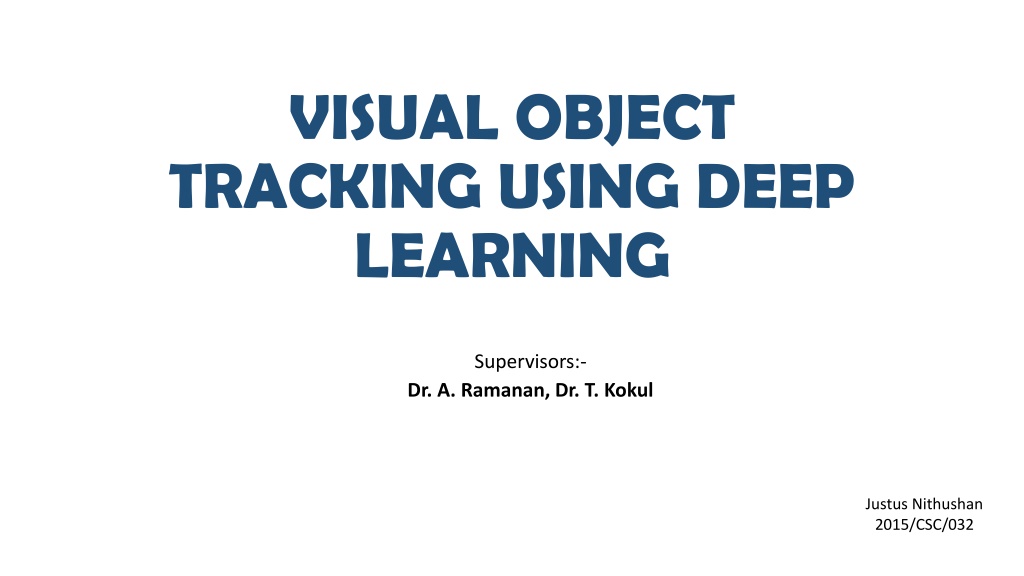
Deep Learning for Visual Object Tracking
"Explore the process of visual object tracking using deep learning techniques, from target initialization to motion estimation. Discover applications in video surveillance, sport analysis, and more. Dive into related works and similarity trackers, along with addressing gaps in model-free tracking. Learn about the initial intended methodology for object classification and segmentation. View examples and insights into the evolving field of object tracking." (Maximum 500 characters)
Download Presentation

Please find below an Image/Link to download the presentation.
The content on the website is provided AS IS for your information and personal use only. It may not be sold, licensed, or shared on other websites without obtaining consent from the author. If you encounter any issues during the download, it is possible that the publisher has removed the file from their server.
You are allowed to download the files provided on this website for personal or commercial use, subject to the condition that they are used lawfully. All files are the property of their respective owners.
The content on the website is provided AS IS for your information and personal use only. It may not be sold, licensed, or shared on other websites without obtaining consent from the author.
E N D
Presentation Transcript
VISUAL OBJECT TRACKING USING DEEP LEARNING Supervisors:- Dr. A. Ramanan, Dr. T. Kokul Justus Nithushan 2015/CSC/032
DEFINITION DEFINITION Object tracking is the process locating a specified moving object in a video sequence
APPLICATIONS APPLICATIONS Video surveillance Abnormal event detection Traffic monitoring Sport analysis Medical imaging
STEPS STEPS 1. Target Initialization Defining the initial state of the target by drawing a bounding box around it. 2. Appearance modelling Learning the visual appearance of the object 3. Motion Estimation Learning to predict a zone where the target is most likely to be present 4. Target positioning Using the visual model to lock down the exact location of the target.
RELATED WORKS RELATED WORKS Classification and Update based Trackers (Tracking by detection) CNN based trackers Transforming knowledge gained from offline training with large-scale datasets (ex:- GOTURN tracker by David held et al. , Wang et al. transformed offline features to online tracking) Offline training and updating the network online to learn domain specific information (ex:- MDNet by Nam and Ham) Correlation filter based Trackers CF trackers learn a correlation filter online to localize the object in consecutive frames. The learned filter is applied to the region of interest in the next frame and the location of the maximum response corresponds to the object location (ex:- Context-Aware Correlation Filter Tracking by Matthias Mueller et al. )
Similarity Trackers (Template matching) CNN based trackers Uses the famous and state of the art Siamese network (ex:- SiamFC by Bertinetto et al.) Boosting informative features Some researches have increased the accuracy by boosting useful/ most dominant information to the model (ex:- Scale-aware Semantic Image Segmentation by L.C Chen et al)
GAPS GAPS Model free tracking need target specific information for online training (ex:- SiamFC architecture was trained without any class specific knowledge) Balancing accuracy and speed
INITIAL INTENDED METHODOLOGY INITIAL INTENDED METHODOLOGY 1. 2. 3. Object Classification of the first frame template using a pre-trained model Segmentation of the target (ex:- pixel wise using Mask R-CNN) Feed the segmented target features into SiamFC network to make it learn the target specific clues
Thank you Thank you
